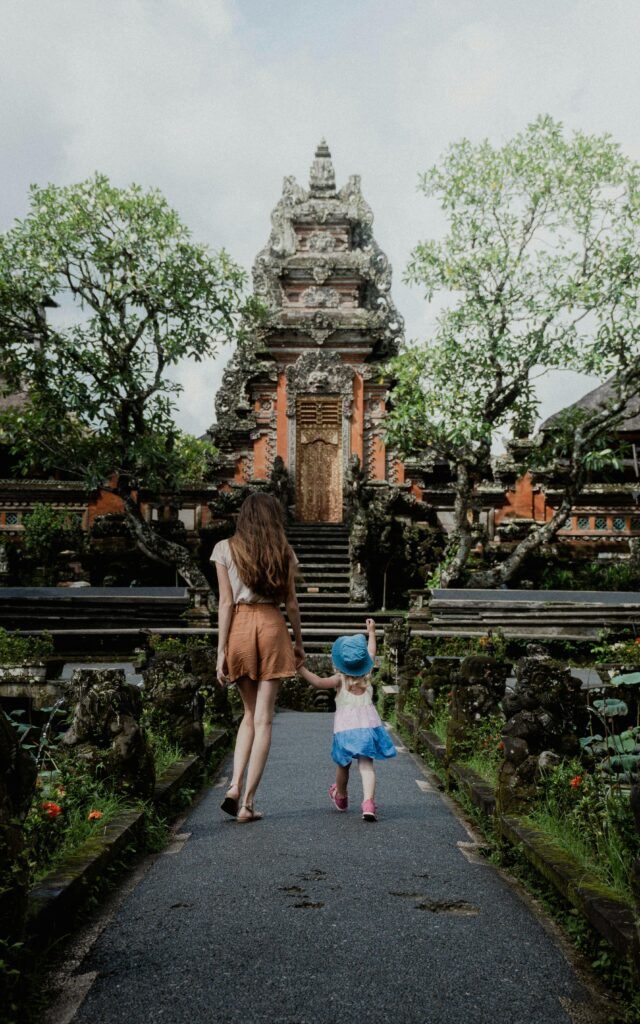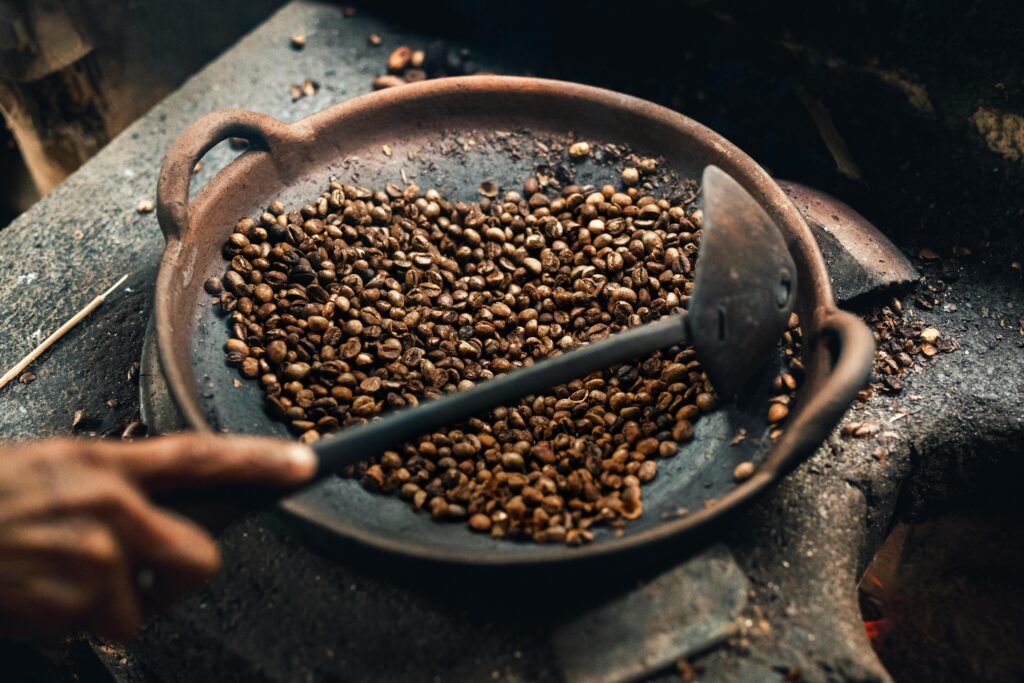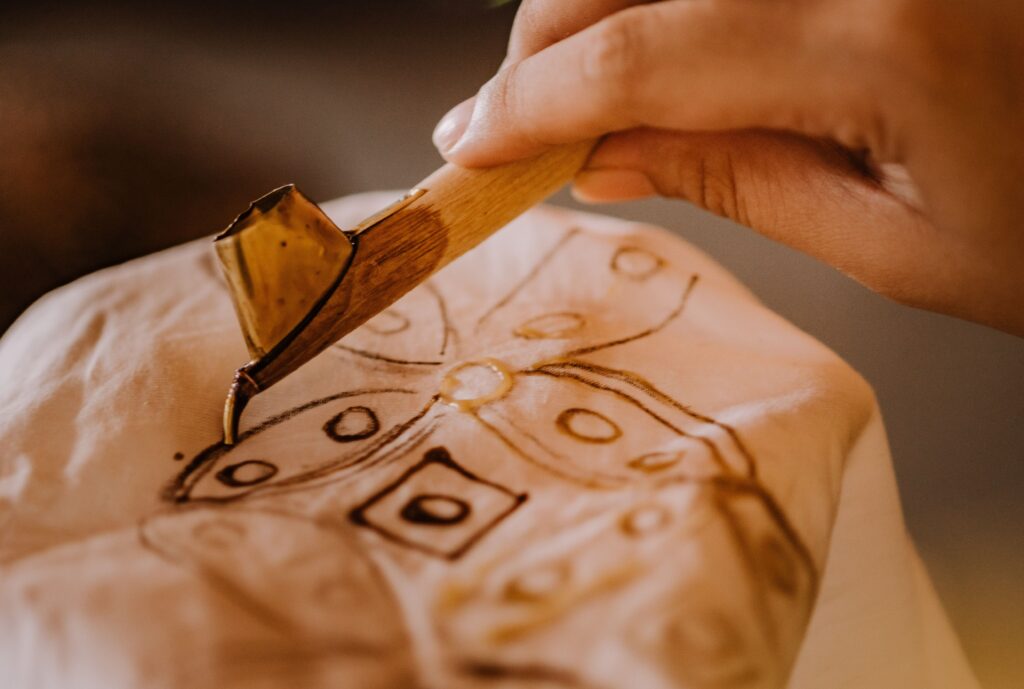Ubud is a vibrant cultural hub brimming with mystical allure and breathtaking landscapes. From ancient temples to adrenaline-pumping adventures, Ubud offers a myriad of experiences that captivate travelers from around the globe. Let’s embark on a journey through some of Ubud’s most enchanting destinations.
1. Monkey Forest Sanctuary

Step into a realm where nature reigns supreme at the Monkey Forest Sanctuary. Home to over 700 playful long-tailed macaques, this lush jungle sanctuary offers visitors a chance to observe these mischievous primates in their natural habitat. Wander through towering trees, ancient temples, and moss-covered statues as you immerse yourself in the tranquil beauty of this sacred forest.
2. Goa Gajah (Elephant Cave)

Delve into Bali’s rich history with a visit to Goa Gajah, also known as the Elephant Cave. Carved into a rock face, this mysterious cave complex features intricate stone carvings, a central meditation chamber, and a bathing pool adorned with Hindu relics. Explore the mystical depths of this ancient sanctuary and uncover the secrets of Bali’s past.
3. Tirta Empul Temple

Experience spiritual purification at Tirta Empul, Bali’s holiest water temple. Believed to have sacred healing powers, the natural spring waters of Tirta Empul attract devotees who come to bathe in its holy waters and perform cleansing rituals. Witness firsthand the devout reverence of Balinese culture as locals and pilgrims partake in age-old traditions passed down through generations.
4. Pura Saraswati

Dedicated to the Hindu goddess of knowledge, arts, and wisdom, Pura Saraswati is a temple of unparalleled beauty. Adorned with intricate carvings, lotus ponds, and lush gardens, this enchanting temple is a testament to Bali’s artistic heritage. Attend a traditional dance performance at the nearby Ubud Palace and immerse yourself in the mesmerizing rhythms of Balinese culture.
5. Luwak Coffee Plantation

Indulge your senses with a visit to a Kopi Luwak plantation and discover the secrets behind the world’s most expensive coffee. Learn about the unique process of coffee production, from harvesting ripe coffee cherries to roasting and brewing the perfect cup of java. Sample a variety of coffee blends, including the famed Kopi Luwak, made from beans that have been excreted by civet cats, resulting in a smooth and distinctive flavor.
6. Bali Swing

Unleash your inner thrill-seeker with an exhilarating ride on a Bali Swing. Soar high above lush rice terraces and verdant valleys as you swing through the jungle canopy. Feel the rush of adrenaline as you take in panoramic views of Bali’s stunning landscapes from dizzying heights.
7. Ayung River Rafting

Embark on an adrenaline-fueled adventure down the rapids of the Ayung River. Navigate through swirling waters and cascading waterfalls as you raft past lush rainforest scenery and towering cliffs. Whether you’re a novice or experienced rafter, Ayung River offers an unforgettable white-water rafting experience amidst Bali’s natural splendor.
8. Ubud ATV Adventure

Embark on a rugged off-road excursion through Bali’s picturesque countryside with an ATV adventure. Traverse muddy trails, rocky terrain, and scenic rice paddies as you explore hidden gems off the beaten path. Feel the thrill of adrenaline coursing through your veins as you conquer Bali’s untamed wilderness aboard a powerful ATV.
9. Campuhan Ridge Walk

Tucked away amidst the lush greenery of Ubud, Bali’s cultural heartland, lies a serene haven known as Campuhan Ridge Walk. This enchanting trail offers a picturesque journey through rolling hills, verdant valleys, and the soothing whispers of nature. Popular among both locals and tourists, the Campuhan Ridge Walk presents an opportunity to escape the hustle and bustle of modern life and immerse oneself in the tranquil beauty of Bali’s countryside.
A Natural Oasis
Nestled between two rivers, the Campuhan Ridge Walk boasts stunning panoramas of Ubud’s emerald landscapes. As visitors embark on this scenic trek, they are greeted by the sight of swaying palm trees, vibrant foliage, and terraced rice paddies cascading down the slopes. The gentle rustle of leaves and the melodious chirping of birds create a harmonious symphony, soothing the senses and inspiring a sense of tranquility.
Cultural Significance
Beyond its natural splendor, Campuhan Ridge holds profound cultural significance for the Balinese people. The word “Campuhan” translates to “the confluence of two rivers” in the local language, symbolizing unity and harmony. It is believed that this sacred site holds spiritual energy, making it a favored spot for meditation and reflection. Visitors often encounter small shrines and offerings along the trail, attesting to the spiritual reverence attached to this revered landscape.
Exploring the Trail
The Campuhan Ridge Walk offers a leisurely trek that caters to all fitness levels. The trailhead is conveniently located near the Blanco Renaissance Museum, just a short distance from Ubud’s bustling center. From there, a paved pathway meanders through lush vegetation, with occasional wooden bridges crossing over streams and ravines. Along the way, benches provide opportunities to pause, take in the breathtaking vistas, and snap photographs of the surrounding scenery.
Tips for Visitors
- Timing: The best time to embark on the Campuhan Ridge Walk is during the early morning or late afternoon when the weather is cooler, and the sunlight bathes the landscape in a golden hue.
- Attire: Comfortable walking shoes and lightweight clothing are recommended, along with sunscreen and a hat to shield against the sun’s rays.
- Hydration: Carry an ample supply of water to stay hydrated throughout the journey, especially during the warmer months.
- Respectful Behavior: As a site of cultural significance, it’s essential to show respect for local customs and traditions. Visitors should refrain from littering and avoid disturbing the natural environment or sacred offerings.
Embracing Tranquility
For those seeking solace amidst nature’s embrace, the Campuhan Ridge Walk offers a serene retreat where time seems to stand still. Whether strolling along the gentle slopes or pausing to meditate amidst the whispering bamboo groves, every step brings a renewed sense of peace and harmony. As the sun dips below the horizon, painting the sky in hues of orange and pink, visitors depart with a deep appreciation for Bali’s timeless beauty and the rejuvenating power of its natural landscapes.
10. Panglipuran Village

Immerse yourself in the timeless charm of Desa Panglipuran, a traditional Balinese village renowned for its pristine beauty and cultural heritage. Wander through narrow pathways lined with intricately carved houses and lush bamboo forests as you experience the authentic way of life in rural Bali. Engage with friendly locals and learn about their customs, rituals, and traditions passed down through generations.
11. Pura Gunung Kawi Tampaksiring

Journey to the sacred temple complex of Pura Gunung Kawi Tampaksiring and marvel at its awe-inspiring architecture and spiritual significance. Carved into sheer cliff faces, the towering shrines and stone monuments pay homage to ancient Balinese kings and deities. Explore the tranquil surroundings of this sacred site and soak in the mystical ambiance of Bali’s spiritual heartland.
12. Embark on a Culinary Journey with Cooking Classes in Ubud

Ubud beckons travelers with its lush landscapes, vibrant arts scene, and tantalizing culinary delights. Amidst the tranquil rice paddies and verdant jungles, one experience stands out as a must-do for food enthusiasts: cooking classes.
Cultural Fusion on a Plate
Ubud’s cooking classes offer more than just a lesson in preparing delicious dishes; they provide a deeper understanding of Balinese culture through its rich culinary heritage. Influenced by various indigenous traditions and interwoven with flavors from neighboring Southeast Asian countries, Balinese cuisine is a delightful fusion of spices, herbs, and fresh ingredients.
The Journey Begins: Exploring Ubud’s Markets
Your culinary adventure commences with a visit to Ubud’s bustling markets, where vibrant stalls overflow with exotic fruits, fragrant spices, and locally-sourced produce. Led by experienced instructors, you’ll learn to select the freshest ingredients while immersing yourself in the vibrant sights, sounds, and scents of Balinese market life.
Mastering the Art of Spice Blending
Back in the serene setting of the cooking class kitchen, it’s time to roll up your sleeves and get hands-on. Guided by expert chefs, you’ll unlock the secrets of Balinese spice blending, discovering the perfect harmony of flavors that define the region’s cuisine. From fiery sambals to aromatic curry pastes, you’ll learn to craft these essential building blocks of Balinese cooking with finesse.
Hands-On Cooking Experience
Under the watchful eye of your instructors, you’ll embark on a culinary journey, mastering age-old techniques passed down through generations. From traditional Balinese dishes like Ayam Betutu (spiced chicken) and Bebek Betutu (spiced duck) to fragrant Nasi Goreng (fried rice) and Lawar (Balinese mixed vegetables), each recipe reveals a story, a tradition, and a unique flavor profile.
Indulge and Enjoy: Balinese Feast
As the aromas of your creations fill the air, it’s time to sit back, relax, and savor the fruits of your labor. Gather around the table with fellow participants, swap stories, and immerse yourself in the convivial atmosphere of a Balinese feast. With a glass of refreshing Jamu (traditional herbal drink) in hand, you’ll taste the culmination of your efforts, each dish a testament to the vibrant culinary tapestry of Bali.
Beyond the Kitchen: Cultural Insights
But Ubud’s cooking classes offer more than just culinary instruction. Alongside learning to wield a wok and perfect your knife skills, you’ll gain insights into Balinese culture, traditions, and way of life. From understanding the significance of offerings (Canang Sari) to learning about the spiritual connection between food and Balinese ceremonies, each lesson transcends mere cooking, offering a profound glimpse into the soul of Bali.
A Taste of Ubud: Take the Experience Home
Armed with newfound culinary skills and a repertoire of authentic Balinese recipes, you’ll return home not just with memories but with the ability to recreate the flavors of Ubud in your own kitchen. Whether you’re whipping up a spicy Sambal Matah for a dinner party or treating yourself to a comforting bowl of Babi Guling (suckling pig), the tastes of Ubud will forever linger on your palate, a reminder of the enriching experience that awaits in Bali’s cultural heart.
In Conclusion: A Feast for the Senses
In Ubud, cooking classes aren’t just about mastering recipes; they’re about unlocking the essence of Balinese cuisine, connecting with local traditions, and immersing yourself in the vibrant tapestry of Balinese life. So, if you’re seeking to unleash your inner chef while exploring the cultural riches of Bali, look no further than Ubud’s culinary scene. Prepare to embark on a journey of flavors, aromas, and unforgettable experiences that will leave you craving more long after you’ve left the island.
13. Silver Class Experience in Ubud

Amidst lush greenery and vibrant cultural scenes, lies Ubud – a serene haven for artisans and travelers alike. Known for its rich tapestry of traditional crafts, Ubud offers a unique opportunity to delve into the world of silver craftsmanship through its renowned Silver Class experiences. As you step into this world of creativity and tradition, you embark on a journey where skill meets culture, resulting in exquisite pieces of wearable art.
The Craftsmanship
Ubud’s Silver Class is not just a workshop; it’s a celebration of the age-old art of silver crafting. Guided by skilled artisans who have inherited their craft from generations past, participants are introduced to the intricate techniques and tools used in creating stunning silver jewelry. From shaping and soldering to engraving and polishing, every step is a testament to the meticulous attention to detail and mastery of the craft.
Hands-On Experience
One of the most captivating aspects of the Silver Class in Ubud is its hands-on approach. Participants are encouraged to roll up their sleeves and dive into the creative process themselves. Under the guidance of experienced instructors, they learn to manipulate silver with precision, bringing their designs to life one hammer strike at a time. Whether it’s crafting a delicate pendant or a bold statement ring, each piece reflects the individual’s creativity and dedication.
Cultural Immersion
Beyond the technical skills, the Silver Class experience in Ubud offers a profound immersion into Balinese culture. As participants work alongside local artisans, they gain insights into the traditions, symbolism, and stories woven into each piece of silver jewelry. From the significance of motifs like the lotus flower to the rituals associated with crafting, every aspect carries a deeper cultural meaning, enriching the learning experience.
Community Connection
At its core, the Silver Class fosters a sense of community and collaboration. Participants come together from different corners of the globe, united by their passion for creativity and craftsmanship. Through shared experiences and shared challenges, bonds are formed, transcending language and cultural barriers. The workshop becomes a melting pot of ideas and perspectives, creating a rich tapestry of human connection.
A Souvenir to Treasure
As the workshop draws to a close, participants leave with more than just a piece of jewelry; they carry with them memories of an unforgettable experience. Each handmade creation serves as a tangible reminder of their journey – a testament to their newfound skills and the vibrant culture that inspired them. Whether it’s worn as a personal adornment or treasured as a memento, the silver jewelry becomes a symbol of creativity, connection, and the spirit of Ubud.
The Silver Class in Ubud transcends the boundaries of a typical workshop, offering a transformative experience where craftsmanship and culture converge. It’s a journey of discovery and creation, where participants not only learn the art of silver crafting but also immerse themselves in the rich tapestry of Balinese culture. As they depart, they carry with them not just a piece of jewelry, but a piece of Ubud – a testament to the enduring legacy of creativity and craftsmanship in this enchanting corner of the world.
14. Batik Painting Classes in Ubud

Ubud, a town in Bali, Indonesia, is renowned for its rich cultural heritage and vibrant arts scene. Among the plethora of artistic experiences it offers, batik painting classes stand out as a unique opportunity for visitors to immerse themselves in the traditional art form of batik.
Batik, an ancient technique of dyeing fabrics, involves using wax to create intricate designs on cloth before applying dyes. This meticulous process results in stunning, multi-colored patterns that are emblematic of Indonesian culture. Ubud, with its deep-rooted artistic traditions, provides the perfect setting for individuals eager to learn this craft.
Several studios and workshops in Ubud offer batik painting classes tailored to different skill levels, from beginners to advanced artists. These classes typically start with an introduction to the history and significance of batik, providing participants with insights into its cultural context. Participants then delve into the practical aspects of batik painting under the guidance of experienced instructors.
One such studio, nestled amidst Ubud’s lush surroundings, is known for its immersive batik painting experiences. Here, participants are greeted with a warm welcome and introduced to the tools and materials used in batik painting. From traditional canting (a tool used for applying wax) to vibrant dyes, every element is carefully curated to facilitate a meaningful learning experience.
Participants are encouraged to unleash their creativity as they sketch out designs on fabric and meticulously apply wax to outline their patterns. The process requires patience and precision, as even the slightest deviation can alter the final outcome. As the designs take shape, participants are guided through the intricate process of dyeing, layering colors to achieve mesmerizing effects.
Beyond mastering the technical aspects, batik painting classes in Ubud offer a space for cultural exchange and personal expression. Participants have the opportunity to engage with local artisans, gaining insights into their techniques and inspirations. This interaction fosters a deeper appreciation for the craft and its significance within Indonesian culture.
Moreover, batik painting classes serve as a therapeutic outlet, allowing participants to disconnect from the hustle and bustle of daily life and immerse themselves in the creative process. The rhythmic motion of applying wax and dyeing fabric has a calming effect, promoting mindfulness and relaxation.
Whether you’re a seasoned artist or a curious traveler seeking a unique cultural experience, batik painting classes in Ubud offer a gateway to Indonesia’s rich artistic heritage. With expert guidance, a supportive environment, and a dash of creativity, participants can create their own masterpiece while forging lasting memories of their time in Ubud.
15. Wood Carving in Ubud

Ubud, renowned for its vibrant culture, lush landscapes, and rich artistic heritage. Among the myriad forms of artistry that flourish in this cultural hub, wood carving stands out as a timeless tradition deeply woven into the fabric of Balinese identity. Ubud’s wood carving tradition not only showcases exceptional craftsmanship but also reflects the island’s spiritual beliefs, mythology, and daily life. In this article, we delve into the captivating world of Ubud wood carving, exploring its history, techniques, significance, and enduring appeal.
A Glimpse into History:
The art of wood carving has deep roots in Balinese culture, dating back centuries. Influenced by Hindu and animistic beliefs, wood carving initially served as a means of ornamentation for sacred temples and palaces. Over time, it evolved into a revered art form practiced by skilled artisans who meticulously crafted intricate designs inspired by mythology, folklore, and nature.
Ubud emerged as a center for wood carving during the 1930s when several Balinese and foreign artists settled in the area, drawn by its serene surroundings and artistic ambiance. These pioneering artists, including the renowned Dutch painter Walter Spies, played a pivotal role in popularizing Ubud as a haven for artistic expression, fostering a vibrant community of wood carvers and artists.
Techniques and Materials:
Ubud wood carving is characterized by its meticulous attention to detail and mastery of traditional carving techniques passed down through generations. Artisans typically work with locally sourced woods such as teak, mahogany, and ebony, carefully selecting each piece for its quality and grain pattern.
The carving process begins with the selection of a suitable wood block, followed by rough shaping using traditional hand tools such as chisels, mallets, and knives. Artisans then refine the form and intricate details, employing a combination of carving, incising, and relief techniques to bring their designs to life. Each piece is painstakingly crafted, requiring hours, if not days, of dedicated workmanship to achieve the desired level of intricacy and finesse.
Themes and Symbolism:
Ubud wood carving encompasses a diverse range of themes, often drawing inspiration from Balinese mythology, Hindu epics such as the Ramayana and Mahabharata, and the island’s lush flora and fauna. Mythical creatures like the Barong, a protective spirit, and the Garuda, a divine bird, feature prominently in many carvings, symbolizing protection, strength, and spiritual significance.
Additionally, scenes depicting daily life, traditional ceremonies, and Balinese dance forms are also commonly portrayed in wood carvings, offering a glimpse into the island’s rich cultural tapestry. Each motif carries its own symbolism and significance, reflecting the artist’s interpretation and cultural heritage.
Significance and Cultural Preservation:
Beyond its aesthetic appeal, Ubud wood carving holds profound cultural significance for the Balinese people, serving as a tangible expression of their identity, spirituality, and interconnectedness with nature. Through their craft, artisans pay homage to age-old traditions, preserving ancestral knowledge and techniques for future generations.
Furthermore, wood carving plays a vital role in Bali’s economy, attracting tourists from around the world who seek to admire and acquire these exquisite works of art. The proliferation of wood carving workshops and galleries in Ubud not only provides employment opportunities for local artisans but also fosters cultural exchange and appreciation among visitors.
Ubud wood carving stands as a testament to Bali’s rich artistic legacy, blending centuries-old traditions with contemporary creativity. Through its intricate designs, masterful craftsmanship, and profound symbolism, it captures the essence of Balinese culture, inviting viewers into a world of myth, spirituality, and natural beauty.
As Ubud continues to evolve as a global center for arts and culture, wood carving remains a cornerstone of its artistic landscape, perpetuating a tradition that transcends generations and borders. In celebrating Ubud’s wood carving heritage, we honor not only the skill and dedication of its artisans but also the enduring spirit of creativity that thrives in this enchanting corner of the world.
Ubud is a treasure trove of cultural wonders and adrenaline-pumping adventures waiting to be discovered. Whether you’re seeking spiritual enlightenment, thrilling escapades, or creative inspiration, Ubud offers an unforgettable journey into the heart and soul of Bali. Embark on an odyssey of discovery and immerse yourself in the enchanting tapestry of Balinese culture, art, and natural beauty that awaits in this captivating destination.
